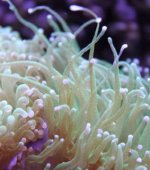Note: The lenses price listed on this post are not up to date.
Choosing a Macro Lens by Working Distance vs. Price
All macro lenses all brutally sharp, so there is little gained discussing/obsessing sharpness comparisons. Here's a different practical way to compare macro lenses: Consider working distances (WD) versus prices when these lenses listed are close focused at full 1:1 magnification:60mm Canon = 10 cm WD @ $440
100mm Canon = 15 cm WD @ $480
150mm Sigma = 20 cm WD @ $620
180mm Tamron = 26cm WD @ $690
180mm Canon = 25 cm WD @ $1,300WD 10cm.
Unless you need this 60mm EF-S macro for specific uses the 100mm Canon macro is a better all around WD value and flexible use for most people. The 60mm is limited to EF-S mount Canon cameras.
I carry this 60mm macro when working in the field with no tripod, as a portable, hand hold able macro that lets me use it a moderate shutter speeds without excessive camera shake blur, as part of a portable field travel kit. It is the only Canon macro that let’s you leave on the filter while using the 14EX or 24EX macro flash units.
If you vacation/travel with a wide angle (e.g., 17-40mm) and telephoto zoom (e.g., 70-200mm f/4) this 60mm becomes the lower light lens as well as the macro.
Those of us who respect Nikkor 60mm micro Nikkor waited a long time for Canon to make one, it just happens (sadly) to be EF-S mount.
WD 15 cm.
You only pay about $40 to add 5 cm of WD from Canon's 60 to 100mm macro lens. Due to floating internal elements, the Canon 100mm has a shorter than 100 mm internal actual focal length at 1:1, likely 70-80mm, maintaining a good field of view while providing 14.9 cm WD. This is a GREAT flexible lens. 5 cm is a big 50% WD distance gain.
WD 20cm.
Pay additional $140 for another 5cm WD step gained from the Canon 100mm to the Sigma 150mm. The Sigma comes with a hood, tripod mount, HSM auto focus with full-time manual over ride (I manually focus much of the time), making it an very good middle contender, if it fits your needs. It is the first Sigma lens ever I used that contributed something important to photography performance; not another a “me-too” price-point product. Sigma4Less.com sells it reasonable.
WD 25cm.
Step up and you pay an added $700 for the next (last) 5 cm WD gained between the Sigma 150mm and the Canon 180mm. This is an amazing optic, little diffraction even when stopped down to f/22+. Ultimate WD.
The longer focal length makes it much easier to compose shots by isolating subjects, eliminating clutter, and much easier to get the lens plane position parallel to where you want the maximum depth of field on the subject.
It's big and long and prefers to be used tripod mounted, except when "butterfly hunting." Works with Canon 1.4x teleconverter as a bonus. The last macro lens you’ll ever buy.
WD 26 cm.
The Tamron is the longest WD versus price value winner, but I did not use nor consider it because a lens filter adjuster may prevent using the MT 24-EX Macro Flash.
What is Working Distance?
WD is the distance from the FRONT of lens element to the subject when the lenses are focused at their closest focus 1:1 magnification. Macro lenses all focus continuously to infinity also, but we are only calculating close focus distance above.
Calculate WD
= published close focus spec for lens - lens length - distance between rear element and sensor or film plane (which is approx. 4.4 cm for Canon EOS camera system.
Light Loss
WD is a BIG limiting use factor (in addition to the full 2 f/stops of light loss @ 1:1 magnification), so get as much WD as you can afford.
If you're serious about macro, try not to buy a macro where the lens barrel length changes during focus. For casual macro users, this is OK (like carrying the old Canon 50mm f/2.5 in a pocket out for a hike).
More Fun at Less than Life Size
When we mean macro, we mean life size reproduction, (1:1) magnification or greater. There is loads of fun "close-up" photography at less than life size, say 0.25x to 0.70x (butterfly and dragonfly hunting range) that you can do with diopters, close focusing zooms, etc. A cheap Canon XXmm-300mm zoom with a Canon 500D ($140) +2 diopter makes a good butterfly hunter, providing about 0.4-0.7x depending on focal length.
Using a wide angle lens close-up enables “a thing in its environment” close-ups,” which are useful and popular.
Hope that helps. Jack
Normally, the common street opinion is, given lenses of similar optical design, the shorter the focal length, the greater the DoF, the longer the focal length, the more distance is compressed behind the plane of focus (less DoF). But this is way too simplistic, and does not hold up under macro close focus distances with floating element macro lenses.
In general:
1. It is a struggle to obtain enough DoF under macro conditions and the lens focal length is less important than framing angle on the subject, etc.
2. Choose a macro lens for its handling, working distance, FL field of view framing, alternate uses, and NOT for perceived DoF differences.
Why?
The relationship between lens focal length and DoF - at macro magnification - is not clear, and there is no guarantee that a shorter focal length macro lens gives more DoF where you want it in a photograph than a longer FL lens. In fact, under macro conditions, the differences between shorter and longer focal length lenses may have more to do with shifting the plane of focus in front or behind the focus point depending on lens focal length. And more to do with framing the subject.
http://photography-on-the.net/forum/showthread.php?p=779256#post779256
POLL
http://photography-on-the.net/forum/showthread.php?t=160960






